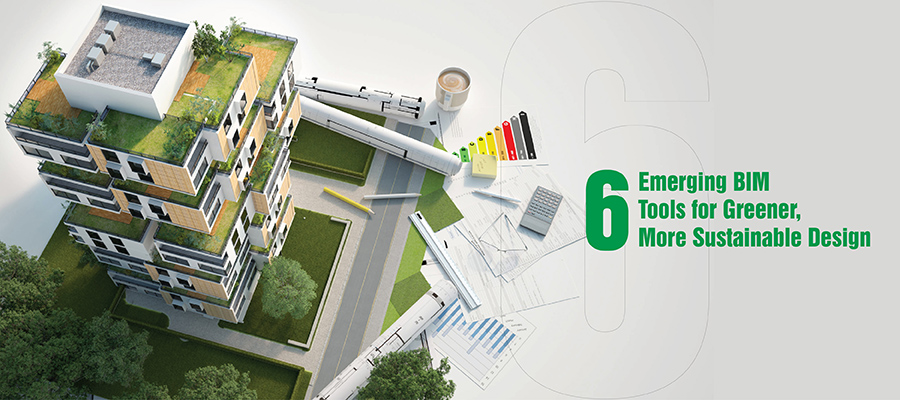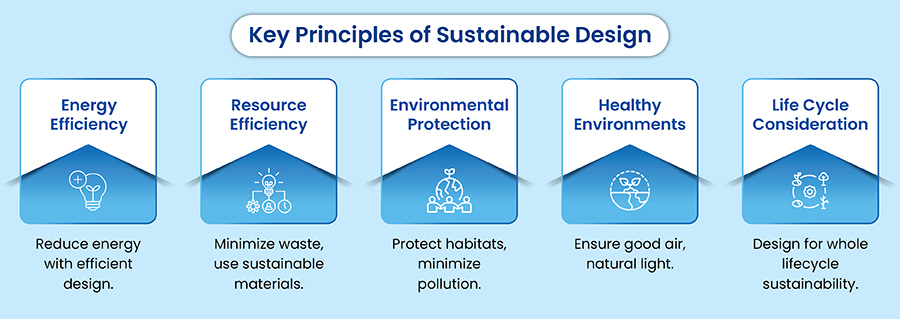How BIM Emerging Technologies Enhances Sustainable Construction Design

Responsible for 37% (5) of global greenhouse gas emissions and substantial resource use, the sector’s environmental footprint is staggering. In the USA alone, the construction industry accounts for 40 percent of atmospheric emissions, 20 percent of water effluents, and 13 percent of other releases (3).
Building Information Modeling (BIM) is emerging as a key tool in this transformation, offering innovative solutions that enhance resource efficiency and reduce carbon footprints.
This blog explores the latest BIM technology developments driving sustainable design forward. From AI-driven generative design to cloud-based collaboration platforms, discover how these cutting-edge technologies are revolutionizing the industry, promoting eco-friendly practices, and meeting stringent sustainability standards. As the industry evolves, these BIM advancements are crucial in building a more sustainable future.
Key Principles of Sustainable Design
 Creating a sustainable built environment involves adhering to several fundamental principles. These principles not only aim to reduce the environmental impact of buildings but also enhance their overall performance and livability. Here are the key principles of sustainable design:
Creating a sustainable built environment involves adhering to several fundamental principles. These principles not only aim to reduce the environmental impact of buildings but also enhance their overall performance and livability. Here are the key principles of sustainable design:
- Energy Efficiency: Reducing energy consumption through design strategies such as proper insulation, energy-efficient windows, and the use of renewable energy sources such as solar panels, wind turbines, and geothermal systems.
- Resource Efficiency: Using materials and resources in a way that minimizes waste and promotes recycling and reuse. This includes selecting sustainable materials and reducing water usage.
- Environmental Protection: Designing in a way that protects natural habitats, reduces pollution, and minimizes the carbon footprint of the building.
- Healthy Environments: Ensuring good indoor air quality, natural lighting, and comfortable thermal conditions to promote the well-being of occupants.
- Life Cycle Consideration: Taking into account the entire life cycle of the building, from design and construction to operation and demolition, to ensure sustainability throughout its lifespan.
- Social Responsibility: Addressing the needs of the community and stakeholders, ensuring that designs are inclusive, accessible, and beneficial to society.
7 BIM Technologies that Impact Sustainable Designs
Innovations in BIM are enhancing efficiency, reducing environmental impact, and promoting resource conservation by ensuring buildings meet stringent sustainability standards.
Here are 7 emerging BIM technologies for sustainable designs:
AI-Driven Generative Design
- What it is: AI-driven generative design is a process that uses algorithms to quickly generate and evaluate multiple design alternatives. It focuses on optimizing key factors like energy efficiency, material usage, and cost, ultimately creating more sustainable and effective building designs.
- How It's Used: AI-driven generative design is used by inputting design parameters and goals into software, which then generates and evaluates numerous design alternatives. This process helps identify the most efficient, sustainable, and cost-effective solutions for building projects.
It is used in the AEC industry to create optimal building designs by analyzing multiple scenarios. It maximizes natural light, minimizes energy consumption, and efficiently uses materials, enhancing sustainability and cost-effectiveness. - Example Project: The MaRS Innovation District in Toronto used generative design to optimize office layouts. The project focused on maximizing natural daylight and reducing energy consumption. Autodesk’s tools such as Autodesk Revit, Autodesk Insight, and Autodesk Dynamo, helped explore various layout configurations. The design enhanced daylight availability, energy efficiency, and occupant comfort. This resulted in significant energy savings and improved workspaces. The project highlights generative design’s potential in sustainable buildings.
Cloud-Based BIM Collaboration Platforms
- What it is: Cloud-based BIM collaboration platforms are online tools that allow project teams to share, access, and manage BIM data in real-time, enhancing communication and coordination throughout the construction process. They enhance accessibility, streamline workflows, and ensure that all team members are working with the most up-to-date information.
- How it’s used: Cloud-based BIM collaboration platforms are used by project teams to facilitate BIM coordination by sharing, accessing, and updating BIM data in real-time. These platforms streamline communication, document sharing, and collaboration among architects, engineers, and contractors. They improve project efficiency, reduce errors, and support sustainable design by enabling better decision-making and resource management throughout the entire BIM Coordination lifecycle.
Cloud-based BIM collaboration platforms enhance sustainability by enabling real-time data sharing and coordination, reducing material waste, and optimizing resource use through improved design and construction efficiency. - Example Project: The Oslo Airport expansion project used BIM 360, a cloud-based platform for seamless collaboration among international teams, focusing on sustainable construction practices and energy-efficient design. It streamlined international teamwork and focused on sustainable construction and energy-efficient design. The platform improved project management and facilitated eco-friendly practices. It also optimized energy performance, reducing consumption and emissions. This made the project a model for sustainable airport design.
BIM-Integrated Life Cycle Assessment (LCA) Tools
- What it is: BIM-integrated Life Cycle Assessment (LCA) tools combine building information modeling with life cycle analysis. They evaluate the environmental impact of a building from design through demolition, promoting sustainable decision-making.
- How it’s used: BIM-integrated LCA tools are used by linking BIM data with LCA databases. This allows designers and engineers to analyze and optimize a building's sustainability performance from early design stages through to its end of life, BIM enables decision-making for a more sustainable design.
- Example Project: The Helsinki Central Library Oodi utilized One Click LCA to evaluate and minimize the environmental impact of its construction materials. By integrating LCA with their BIM models, the project team was able to make informed decisions that significantly reduced the building's carbon footprint, resulting in a more sustainable and eco-friendly structure.
Embodied Carbon Calculation Tools
- What it is: Embodied Carbon Calculation Tools measure the total greenhouse gas emissions associated with the production, transportation, installation, maintenance, and disposal of building materials. These tools help quantify and minimize the carbon footprint of construction projects, promoting sustainability.
- How it's used: These tools integrate with BIM software to analyze and calculate the embodied carbon of different materials and construction processes. They enable architects and engineers to make data-driven decisions to reduce emissions, optimize material selection, and achieve greener building designs. These tools calculate the carbon footprint of construction materials and processes, helping designers choose low-carbon options.
- Example Project: Microsoft’s Redmond Campus renovation project leveraged the EC3 tool to identify and select materials with lower embodied carbon. This strategic use of EC3 enabled the project to align with Microsoft’s sustainability targets, significantly reducing the overall carbon footprint of the renovation and promoting greener construction practices.
BIM-Enhanced Building Energy Modeling (BEM)
- What it is: BIM-enhanced building energy modeling (BEM) uses BIM data to simulate and analyze a building’s energy performance, helping to optimize energy use and improve sustainability.
- How it's used: BIM-enhanced BEM tools integrate with BIM software like Autodesk Revit, EnergyPlus etc.to perform energy simulations. Designers and engineers use these tools to optimize HVAC systems, lighting, and building envelopes, ensuring the design achieves optimal energy efficiency and meets sustainability goals throughout the project lifecycle.
It helps optimize design for energy efficiency, sustainability, and compliance with energy standards. This process helps predict energy consumption, efficiency, and savings, ensuring designs meet sustainability standards and reduce overall energy usage. - Example Project: Buro Happold's office in London utilized IES VE for detailed energy modeling to enhance their building design. By simulating various energy scenarios, the team identified strategies to significantly reduce energy consumption and improve overall sustainability. This approach led to a highly efficient, eco-friendly office environment that meets stringent sustainability standards.
Parametric and Computational Design Tools
- What it is: Parametric and computational design tools use algorithms and variable parameters to create flexible and dynamic architectural models. These tools allow designers to explore numerous design possibilities quickly, optimizing for factors like efficiency, aesthetics, and sustainability.
- How it's used: Designers input parameters and rules into these tools, which then generate and test various design iterations. This process enables the creation of optimized, data-driven solutions that meet specific project requirements, enhancing creativity, precision, and efficiency in sustainable building design.
- Example Project: The Al Bahar Towers in Abu Dhabi utilized parametric design tools to create an innovative dynamic facade. This facade features a responsive shading system that adjusts to the sun's position, significantly reducing solar heat gain and enhancing energy efficiency. The design not only improves sustainability but also creates a visually striking architectural landmark.
BIM for Daylighting and Natural Ventilation Analysis
- What it is: BIM for daylighting and natural ventilation analysis uses BIM software to simulate and evaluate the effects of natural light and airflow within a building, optimizing these elements for energy efficiency and occupant comfort.
- How it's used: Designers use BIM tools to model and analyze natural light and ventilation patterns, adjusting designs to maximize daylight, enhance air circulation, reduce reliance on artificial lighting and HVAC systems, and improve indoor environmental quality.
- Example Project: The Edge building in Amsterdam utilized tools like Autodesk Insight and IES VE to design a workspace that maximizes daylight and natural ventilation. This approach significantly reduced energy consumption by minimizing the need for artificial lighting and HVAC systems, creating a highly sustainable and comfortable environment for occupants. The building has been recognized for its exceptional energy efficiency and innovative design.
Conclusion
In conclusion, adopting the latest BIM technologies for AEC firm are important for guiding the construction industry toward sustainable design. The urgency for greener practices is clear, given the sector’s substantial contribution to global emissions and resource depletion.
By integrating AI-driven generative design, cloud-based collaboration platforms, and other advanced tools, BIM significantly reduces environmental impacts, enhances resource efficiency, and meets stringent sustainability standards.
As demonstrated by pioneering projects, these BIM innovations are not just theoretical but practical solutions driving real change. Embracing these advancements is essential for the construction industry to mitigate its environmental footprint and build a more sustainable future. By leveraging the power of BIM, we can create buildings that are not only efficient and cost-effective but also environmentally responsible.
